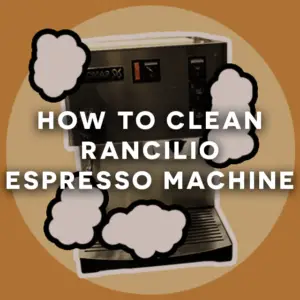
A 20 BAR Espresso Machine uses 9 to 11 on the pressure scale and results in rich and flavorful espresso that can be found in coffee shops and cafes. Meanwhile, a 19 BAR Espresso Machine uses 8 to 11 on the pressure scale, which means it can’t push flavors out of the coffee beans as a 20 BAR could. But is almost equally as good as a 20 BAR Espresso Machine.
Espresso machines come in all shapes and sizes, and even BARS. That’s why it’s important to know what BAR machine you should get to produce the richest and most flavorful espresso for your needs.
Let’s get started.
Contents
What’s The Difference Between 19 BARS and 20 BARS Espresso Machines?
If you’re looking to get a 19 or 20 BAR espresso machine then you’re on the right track to make some quality espresso. But is there a reasonable difference between them to get one over the other?
Not really from my experience, both BARS are almost equal. Let’s see why.
19 BAR Espresso Machine
A 19 BAR Espresso Machine is a big machine and is almost guaranteed to hit the 9 to 11 BAR range on the pressure scale.
This is almost as close as the espresso you’ll get in a coffee shop, cafe, etc. and you might not even taste the difference at all.
If you’re looking for a 19 BAR Espresso Machine then I recommend this Brim Espresso Machine.
20 BAR Espresso Machine
A 20 BAR Espresso Machine is a serious toy and is absolutely guaranteed to hit the 9 to 11 BAR range on the pressure scale, which is the sweet spot for professional baristas, coffee shops, cafes, etc.
Using a 20 BAR Machine makes sure it doesn’t lose too much water by the time the water reaches your coffee grounds. This ensures there is enough pressure which will give you a very rich, strong, and flavorful espresso.
Because of the difference in the pressure scale, you will get quite a substantial amount of delicious and bold crema, which is perfect for that iconic look but also the taste that you crave when you order an espresso.
If you’re looking for a decent 20 BAR espresso machine that doesn’t break the bank, then I recommend this Gevi Espresso Machine.
You should also read my other article on why it’s important to pick a known coffee brand.
What is a BAR?
A BAR is a unit of measurement which is designed to measure pressure according to the atmospheric level at sea. If you’re in America you may be more familiar with the term “pounds per square inch” or “PSI”.
1 BAR equals 14.7 PSI, or the atmospheric level naturally at sea, so the higher the number of BARS your espresso machine uses, the more pressure it will use to push water through the coffee grounds.
I hope that gives you a better understanding of why we use the BAR measurement on espresso machines!
Do BARS in Espresso Machines Make a Difference?
Absolutely! The differences in pressure play the biggest role in an espresso machine. Once you get a machine, you also can’t change the pressure, so it’s important to take the right one that fits you.
Professional businesses like coffee shops and cafes have industrial espresso machines which have their BARS somewhere between 7 and 11, with the ideal being 9 BARS.
The main problem is that regular espresso machines give it a lower BAR than it claims to have, which means in order to get the perfect espresso, you need an espresso machine with a higher BAR than you’d think you would need.
Guide for BARS on Industrial Espresso Machines
Regular Espresso Machines will usually group their BARS together. With a BAR of 7 to 9 or less, you may find your espresso not near where you want it to be. This is simply because it doesn’t have enough pressure, the water being forced through the coffee grounds cannot make its way through and have too little force to push the flavor and oil out of the coffee grounds. This leaves you with a weak espresso and little to no crema.
With a BAR of 10 to 15 for your home espresso machine, you can expect a decent espresso. The pressure in these machines is much stronger and it can force out the flavor of the coffee grounds for a moderately strong taste. It can also create some crema, but not quite as much as you’d like.
The big toys of espresso machines that have a BAR of 15 to 20 are where you truly want your espresso machine to sit. If you’re serious about your espresso then you need one of these. This amount of pressure makes up for the pressure loss during water travels, this gives you the actual 7 to 11 BARS of pressure, which is the sweet spot.
This pressure pulls most flavor of the coffee grounds and leaves you with a rich taste and beautiful espresso, while also giving you a delicious and frothy crema.
Piston VS Pump Espresso Machines
There are 2 types of Espresso Machines: piston and pump.
Piston Espresso Machines
Espresso machines that use a piston will first heat water to boiling. After that you have to pull a lever (this moves the piston, hence the name) which will pressurize the water and force it through the coffee grounds which are in a single chamber with many small holes for even coffee filtration. This can result in consistent coffee flavor, but lack the rich crema that many espresso lovers like.
Pump Espresso machines
The Pump Espresso Machine is a more effective version of the piston machine which produces more flavorful espresso and frothy crema. The pump espresso machine can heat water to 2 temperatures, one for boiling and one for steaming, this allows you to froth milk as you make your coffee.
The entire process is automated so there’s no need to pull a lever. Your only job is to make sure the water reservoir is filled and push the brew button, once pushed it will boil the water and pressurize it, then force the water through the coffee grounds which are in a double chamber this time.
The first chamber contains the coffee grounds and lets the water filter through into the second chamber containing a small area that builds pressure because there is only one hole for the coffee to get out of, rather than many like the piston espresso machines.
This means that pump espresso machines build much more pressure and force the coffee out which produces a much richer espresso with a frothy crema.
How To Use a 20 BAR Espresso Machine For Coffee
Making an espresso using a 20 BAR espresso machine is quite straightforward.
- Fill the water tank to the designated line.
- Turn on your 20 BAR Espresso Machine
- Either make your own finely ground beans, or buy pre-ground. Just makes sure they are very finely ground.
- Grab the machine’s measuring scoop, take 1 scoop of coffee grounds, and put them into the portable filter.
- Once you packed your coffee grounds into the portable filter, simply pick it up, insert it under the tap, and twist it the correct way to lock it securely, so no water, air, or coffee escapes during the brewing process.
- Depending on the machine, the brew will start automatically as the handle locks in place, or you may have to push a BREW button.
- Once again, depending on the machine, you may have to click the BREW button again when the time is right to stop brewing, or the machine will stop on its own.
- Enjoy your delicious 20 BAR espresso!
The Bottom Line
In my experience, there isn’t much of a difference between 19 and 20 BAR Espresso Machines. The 20 BAR machines just have that slight advantage of pushing out water just a bit higher, but both machines should give you a fairly even taste of espresso with a nice amount of crema.







